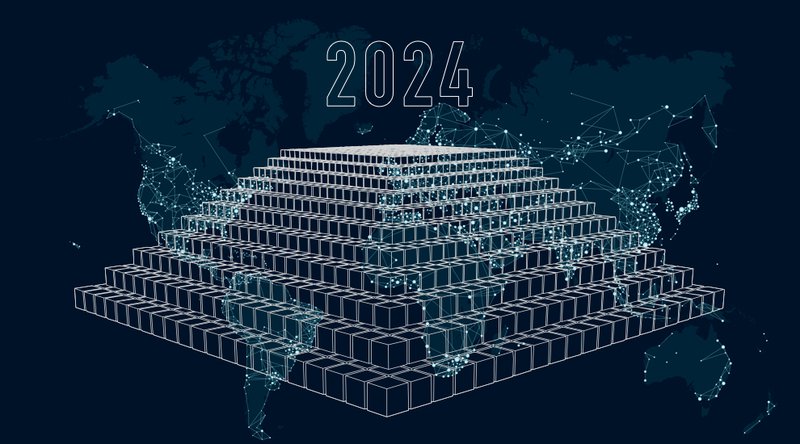Do you know 15 New Surprising Stats About Blockchain in 2023? As we head into 2023, it’s clear that blockchain technology is set to transform the way we live and do business. From finance to healthcare, supply chain management to cybersecurity, blockchain is poised to revolutionize a wide range of industries. In this article, we’ll explore 15 new and surprising stats about blockchain in 2023 that highlight just how powerful this technology is becoming.
Read More: How to Build Blockchain Android Apps
Explore the Contents
- 1 Introduction:
- 1.1 1. The global blockchain market is expected to reach $60 billion by 2024
- 1.2 2. The number of blockchain patents filed has increased significantly
- 1.3 3. Blockchain-based supply chain solutions are expected to save $450 billion annually by 2023
- 1.4 4. The global blockchain identity management market is expected to grow to $3.6 billion by 2025
- 1.5 5. The number of active blockchain wallets has increased significantly
- 1.6 6. The global blockchain in healthcare market is expected to grow to $5.61 billion by 2025
- 1.7 7. The use of blockchain in the gaming industry is on the rise
- 1.8 8. The number of blockchain-based startups is increasing
- 1.9 9. The global blockchain in media and entertainment market is expected to grow to $1.5 billion by 2024
- 1.10 10. The use of blockchain in the real estate industry is expected to increase
- 1.11 11. The global blockchain in energy market is expected to grow to $1.89 billion by 2025
- 1.12 12. The use of blockchain in the finance industry is increasing
- 1.13 13. Blockchain is expected to create 1.4 million jobs by 2023
- 1.14 14. The number of blockchain-based smart contracts is increasing
- 1.15 15. Blockchain is expected to play a key role in the future of voting
- 2 Conclusion
Introduction:
Blockchain technology has been around for over a decade, but its potential is still being explored. With its decentralized, secure, and transparent nature, blockchain is well-suited to solve many of the challenges that businesses face today. In 2023, we can expect to see even more adoption of this technology, as companies and governments realize its value. Here are 15 new and surprising stats about blockchain in 2023 that demonstrate just how transformative it is becoming.
1. The global blockchain market is expected to reach $60 billion by 2024

According to a report by Markets and Markets, the global blockchain market is projected to grow from $3 billion in 2020 to $60 billion by 2024. This represents a compound annual growth rate of 67.3% over the forecast period.
2. The number of blockchain patents filed has increased significantly
According to the World Intellectual Property Organization, the number of blockchain patent filings has increased significantly in recent years. In 2021 alone, there were over 11,000 blockchain patent applications filed globally.
3. Blockchain-based supply chain solutions are expected to save $450 billion annually by 2023

According to a report by Juniper Research, blockchain-based supply chain solutions are expected to save companies up to $450 billion annually by 2023. This is due to the increased transparency and efficiency that blockchain provides.
4. The global blockchain identity management market is expected to grow to $3.6 billion by 2025
According to a report by Markets and Markets, the global blockchain identity management market is expected to grow from $90 million in 2020 to $3.6 billion by 2025. This represents a compound annual growth rate of 114.2% over the forecast period.
5. The number of active blockchain wallets has increased significantly
According to data from Blockchain.com, the number of active blockchain wallets has increased significantly in recent years. As of January 2023, there were over 82 million active blockchain wallets worldwide.
6. The global blockchain in healthcare market is expected to grow to $5.61 billion by 2025
According to a report by Markets and Markets, the global blockchain in healthcare market is expected to grow from $176.8 million in 2020 to $5.61 billion by 2025. This represents a compound annual growth rate of 68.0% over the forecast period.
7. The use of blockchain in the gaming industry is on the rise
According to a report by Blocklete Games, the use of blockchain in the gaming industry is on the rise. The report found that 63% of gamers are interested in blockchain-based games, and 54% of developers are currently working on blockchain-based games.
8. The number of blockchain-based startups is increasing
According to data from Crunchbase, the number of blockchain-based startups has been increasing in recent years. As of January 2023, there were over 8,000 blockchain-based startups worldwide.
9. The global blockchain in media and entertainment market is expected to grow to $1.5 billion by 2024
According to a report by Markets and Markets, the global blockchain in media and entertainment market is expected to grow from $65 million in 2020 to $1.5 billion by 2024. This represents a compound annual growth rate of 81.1% over the forecast period.
10. The use of blockchain in the real estate industry is expected to increase

According to a report by Deloitte, the use of blockchain in the real estate industry is expected to increase in the coming years. The report found that 86% of real estate professionals believe that blockchain will have a significant impact on the industry.
11. The global blockchain in energy market is expected to grow to $1.89 billion by 2025
According to a report by Markets and Markets, the global blockchain in energy market is expected to grow from $181.3 million in 2020 to $1.89 billion by 2025. This represents a compound annual growth rate of 59.5% over the forecast period.
12. The use of blockchain in the finance industry is increasing
According to a report by PwC, the use of blockchain in the finance industry is increasing. The report found that 77% of financial institutions are expected to adopt blockchain technology by 2022.
13. Blockchain is expected to create 1.4 million jobs by 2023
According to a report by the European Union, blockchain is expected to create 1.4 million jobs by 2023. These jobs will be in a variety of industries, including finance, healthcare, and supply chain management.
14. The number of blockchain-based smart contracts is increasing
According to data from CoinMetrics, the number of blockchain-based smart contracts is increasing. As of January 2023, there were over 2.6 million smart contracts on the Ethereum blockchain alone.
Read More: Most Common Blockchains Used by Different Sectors
15. Blockchain is expected to play a key role in the future of voting
According to a report by the National Conference of State Legislatures, blockchain is expected to play a key role in the future of voting. The report found that blockchain technology can improve the security and transparency of the voting process.
Conclusion
In conclusion, the statistics presented about blockchain technology in 2023 demonstrate the continued growth and impact of this innovative technology across various industries. From the increased adoption of cryptocurrencies to the integration of blockchain in supply chain management and healthcare, blockchain is proving to be a versatile tool for businesses and organizations. However, as the technology continues to evolve, it will also face challenges such as regulatory issues and security concerns. It will be interesting to see how these trends develop in the coming years and how blockchain will continue to shape the future of technology and business.
What is blockchain technology?
Blockchain is a digital ledger that records transactions in a secure and transparent way. It uses cryptography to ensure that transactions are authentic and cannot be tampered with.
What are some of the benefits of blockchain?
Some of the benefits of blockchain include increased security, transparency, and efficiency. It also enables the creation of decentralized systems that are not controlled by a single entity.
Can blockchain be used for things other than cryptocurrencies?
Yes, blockchain can be used for a variety of applications beyond cryptocurrencies. Some examples include supply chain management, voting, and digital identity verification.
How does blockchain improve the security of transactions?
Blockchain uses cryptography to ensure that transactions are authentic and cannot be tampered with. Each transaction is recorded on a block that is linked to previous blocks, creating a chain of information that is difficult to alter.
What are some of the challenges facing the widespread adoption of blockchain?
Some of the challenges facing the widespread adoption of blockchain include regulatory uncertainty, scalability issues, and the need for more user-friendly interfaces. As the technology continues to evolve, these challenges are expected to be addressed over time.



